Work packages phase II
Purpose and Research Objectives of the Work Package
How can the multifunctional effects of blue-green water and energy infrastructures be integrated into the planning phases of the new construction district L416?In Leipzig BlauGrün II, the structures established in the first project phase are utilized to prioritize water-sensitive urban development in all subsequent planning steps of the new construction district L416. The new district is planned to include a school, designed with the scientific support of the Office for Building Management to become a showcase project for sustainable rainwater management.
Planned Products or Results
Approval planning of the L-416 district in the Co-Design Process
In the summer of 2022, the development plan (B-Plan) was publicly displayed. The evaluation of the submitted statements indicated that there would be no significant changes to the provisions of the development plan until the formulation of the statute resolution. This provided the administration with a solid basis for developing a urban development contract (SV) for the development plan.The urban development contract aims to contractually fix regulations established in the development plan and content that goes beyond the regulatory framework of the B-Plan between the city and the project developer. This includes, for example, specifications for precipitation water management facilities and irrigation systems. Since the city council resolution on the master plan at the end of 2020, representatives from municipal offices and planners of the project developer had, in weekly multi-hour coordination sessions, consensually coordinated the planning contents, the so-called "regular appointments." These were developed in the preceding process under the scientific guidance of the UFZ.
Furthermore, the urban development contract regulated the transfer of green and traffic areas to the city, green and nature conservation measures, financing of daycare and primary school places, affordable housing, and the specification and implementation of the mobility concept.
On July 5, 2023, the city council of Leipzig passed the resolution on the urban development contract and the development plan 416. With this, the formal process of establishing the B-Plan was completed.
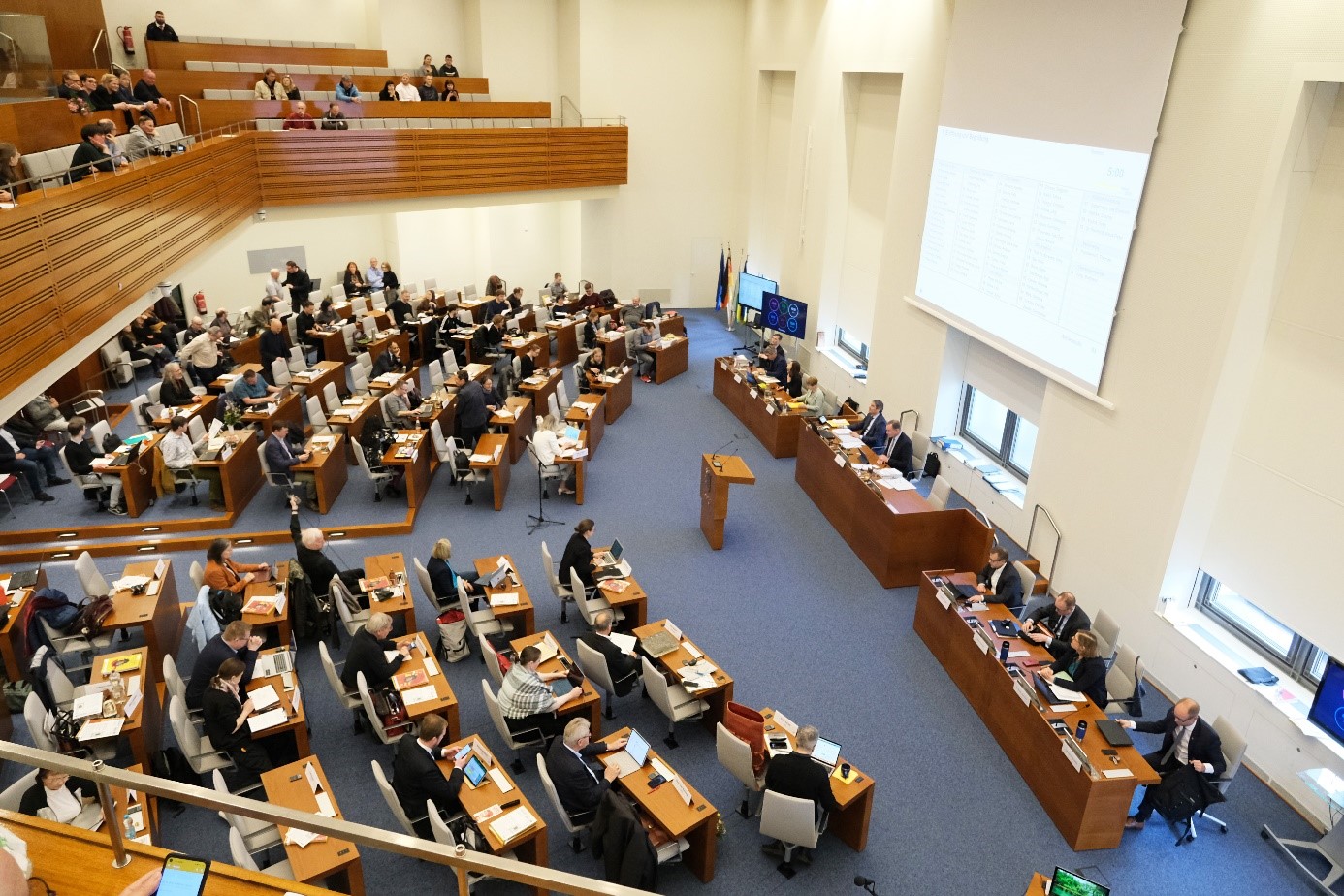 City Council Resolution in the Council Plenary Hall.
City Council Resolution in the Council Plenary Hall.
The precipitation water generated on the building plots in the planning area must be retained by retention elements. If, despite green roofing and storage, it drains off and is not used for non-potable water purposes, it must be infiltrated on the respective building plot in accordance with the following provisions. Interim storage is permissible.
On the building plots in the planning area, heavy rainfall events with a statistical return probability of 100 years must be captured without runoff from the sub-area using suitable measures (e.g., green roofing with storage lamellae, infiltration trenches, storage facilities, infiltration systems). Captured precipitation water is to be stored or infiltrated unless it is used for irrigation or non-potable water purposes.
Precipitation water from rainfall events exceeding a heavy rainfall event with a statistical return probability of 100 years is to be safely discharged into the flood basin in sub-area G3 (central area) of the designated green space.
[§ 9 para. 1 No. 20, No. 25 BauGB]
The aforementioned textual provisions of the B-Plan and formulations in the urban development contract serve as the basis for municipal commitments regarding water-sensitive urban development, developed in Leipzig BlauGrün II (see Work Package 5).
 Planned Products or Results of Work Package 1.
Planned Products or Results of Work Package 1.
Water-Sensitive Residential Block: Optimization proposals for an integrated planning of coupled blue-green infrastructures at the residential block level in the L-416 district
Information will be provided shortly!
Technology Study on Irrigation/Control Variants and Operation of an Inner-City Large-Scale Irrigation System
Open spaces are often threatened by damage during periods of drought, leading to plant death and associated repair and follow-up costs. Therefore, in times of climate change, the conceptual consideration of possible irrigation regimes becomes an increasingly important planning task. Besides damage prevention, factors such as urban climatic conditions (evaporative cooling), aesthetic, and economic parameters are relevant in the selection of technology. In AP 1, various possibilities for water supply for irrigation will be compared. Cisterns (non-potable water), retention in green roofs, groundwater wells, or drinking water are possible approaches to supply water to irrigation systems. Different approaches for distributing water in the vegetation areas to be irrigated are also conceivable. In addition to above-ground irrigation with hoses, above-ground drip irrigation, dust irrigation, and sub-surface drip irrigation will be evaluated for their suitability for water application in the L-416 district.
Technical and Operational Design of a Resilient Energy System and Implementation in the Approval Planning of the L-416 District
In Phase 1 of the project, the potential of the L416 energy system (heat, electricity, e-mobility) was already demonstrated. The incorporation of these potentials into the design and approval planning of L416 is the task of the work package in Phase 2. In this work package, further details for the planning of the resource-efficient energy system were developed. In particular, the innovative approach of utilizing wastewater heat from a nearby main collector of the Leipzig Waterworks was focused on. Coordination took place between the system manufacturer, Leipzig Stadtwerke (LSW), Leipzig Waterworks (LWW), and Tilia GmbH regarding the planning details of installations in the wastewater canal. Questions regarding the sizing of system components were also concretized. At the object level, a detailed design of the energy components specifically for the school building on the district site is planned in the next steps.
Further tests on the pilot plant of the retention-cooling roof on the UFZ premises in Leipzig from Phase 1 of the project were and will also be conducted.
Contributors in the Work Package
- Dr. Ganbaatar Khurelbaatar - Helmholtz-Zentrum für Umweltforschung – UFZ
- Dr. Uta Richter - Stadtplanungsamt Stadt Leipzig
- Rüdiger Clausen - GFSL gruen fuer stadt + leben landschaftsarchitektur eG
- Stefan Böttger - Tilia GmbH
- Markus Krüger – Leipziger Stadtwerke - LSW
Purpose and Research Objectives of the Work Package
The implementation of water- and energy-efficient climate adaptation measures in existing buildings requires the integration of existing building structures and management systems. The current practice involves integrating blue-green individual measures (e.g., green roofs) during the modernization or renovation of existing buildings. The integrated use of the multifunctionality of the overall system concerning sewer relief, cooling, energy efficiency, and vegetation vitality is often not considered. Against this background, AP 2 investigates how the multifunctional effects of blue-green water and energy infrastructures can be implemented in existing neighborhoods. The goal of AP 2 is to develop a transferable solution concept for a water- and energy-efficient existing neighborhood, using the example of the Kolonnadenviertel of the Leipzig Housing Association (LWB) (Figure 1).
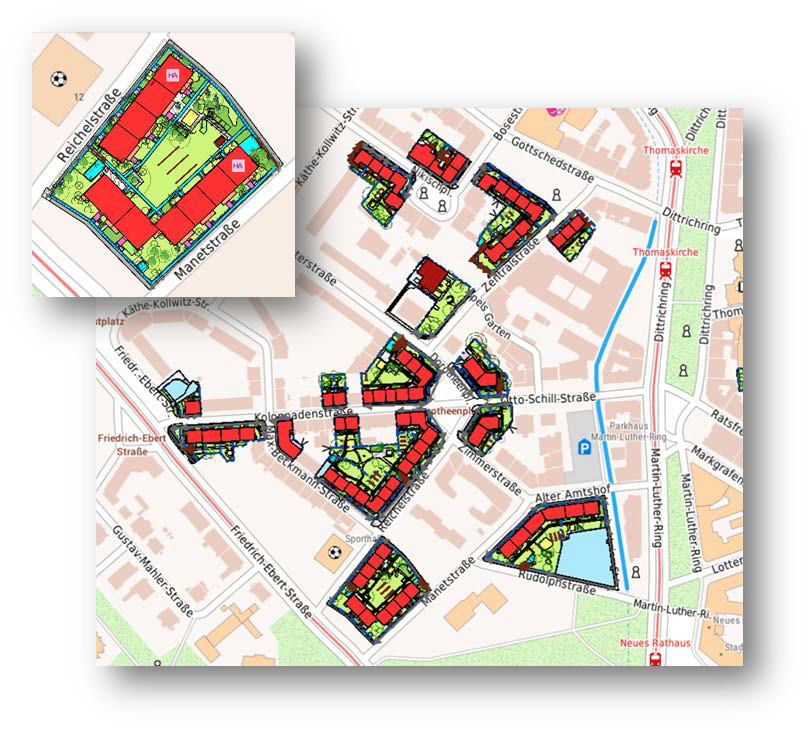 Construction Phases of the Kolonnadenviertel by LWB.
Construction Phases of the Kolonnadenviertel by LWB.
Planned Products or Results
Product No. 1: Implementation of blue-green modernization measures in the Kolonnadenviertel
Within a co-design process involving planners, the LWB, and representatives from the scientific community, blue-green scenarios with different objectives were defined.
- A runoff-free neighborhood during heavy rain events (HQ100). As the preferred solution for the retention of HQ100 with blue-green infrastructure, infiltration basins with varying depths in combination with 2 types of green roofs (Figure 2) were studied and simulated in the SWMM modeling program.
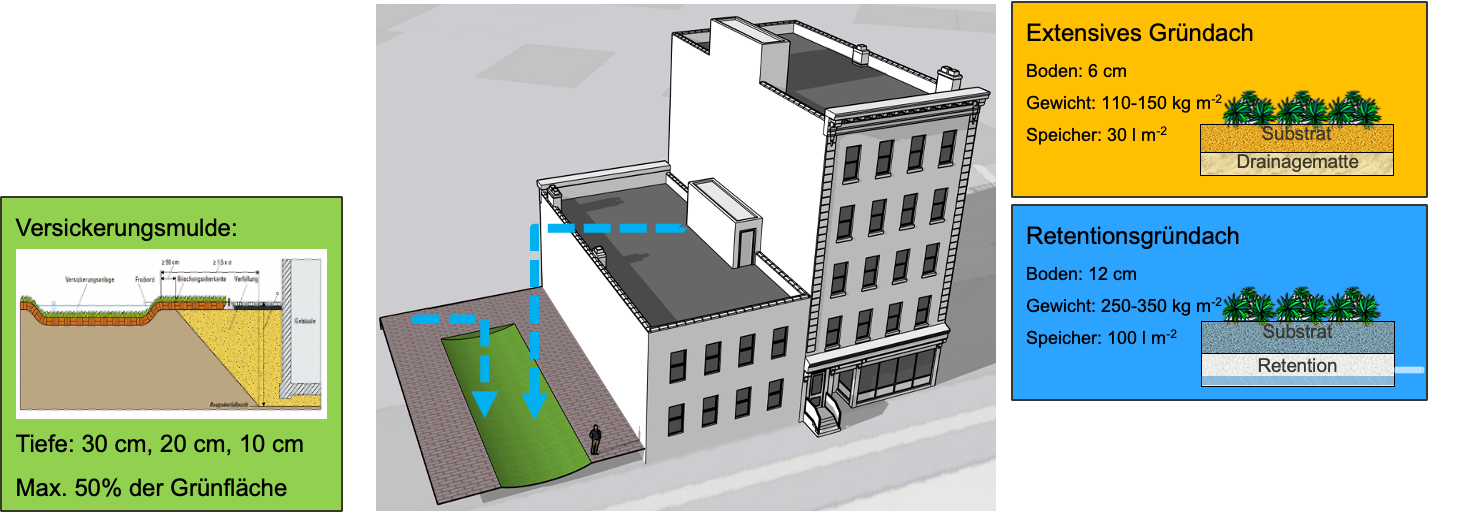 Examined Preferred Solution for Heavy Rainfall Management.
Examined Preferred Solution for Heavy Rainfall Management.
- Approximation to the water balance of the undeveloped state (reference value according to NatUrWB) or balanced water balance (Figure 3). To determine specific measures, the long-term water balance for the Kolonnadenviertel was calculated and compared to the reference value. To approximate the reference value, the current water balance must be modified to increase evaporation and infiltration while drastically reducing surface runoff.
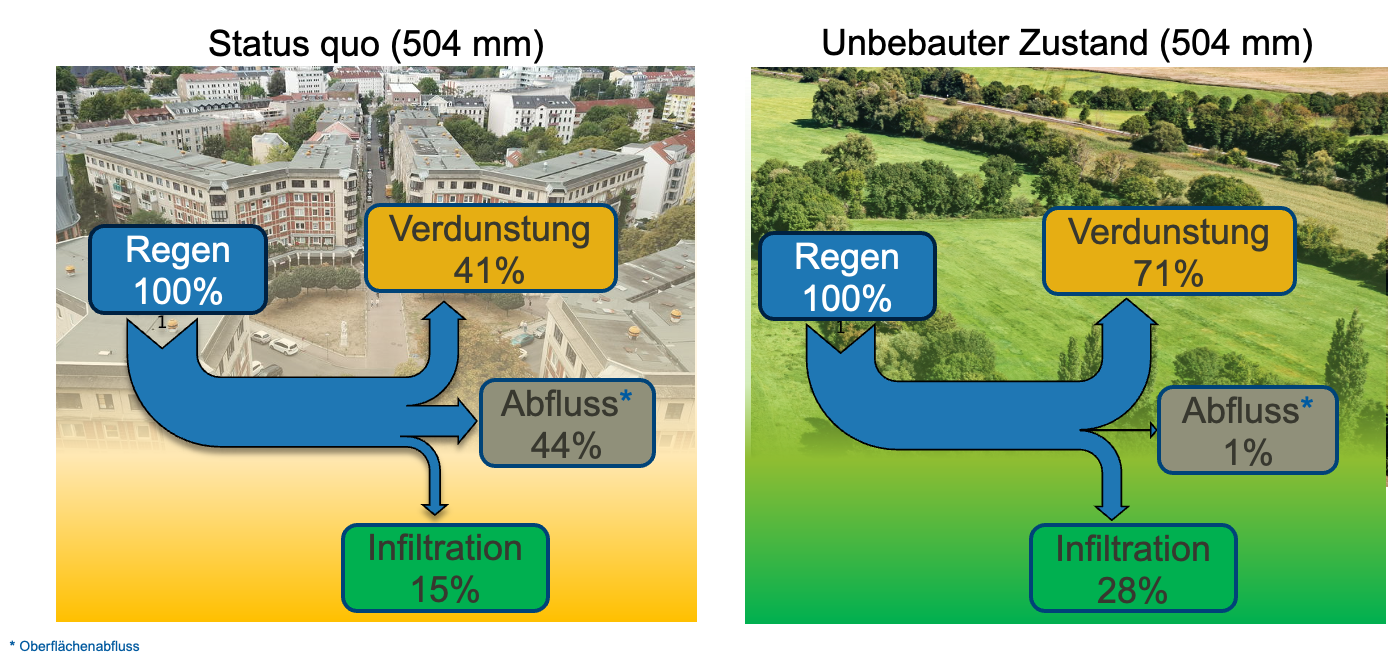 Annual Water Balance of the Kolonnadenviertel Compared to the Reference Value.
Annual Water Balance of the Kolonnadenviertel Compared to the Reference Value.
Product No. 2: Preferred solution for decentralized rainwater management in the Kolonnadenviertel based on the modernization project
The co-design process agreed-upon preferred solution for rainwater management was modeled for the entire Kolonnadenviertel, and the dimensions of the infrastructure were calculated (Figure 4).
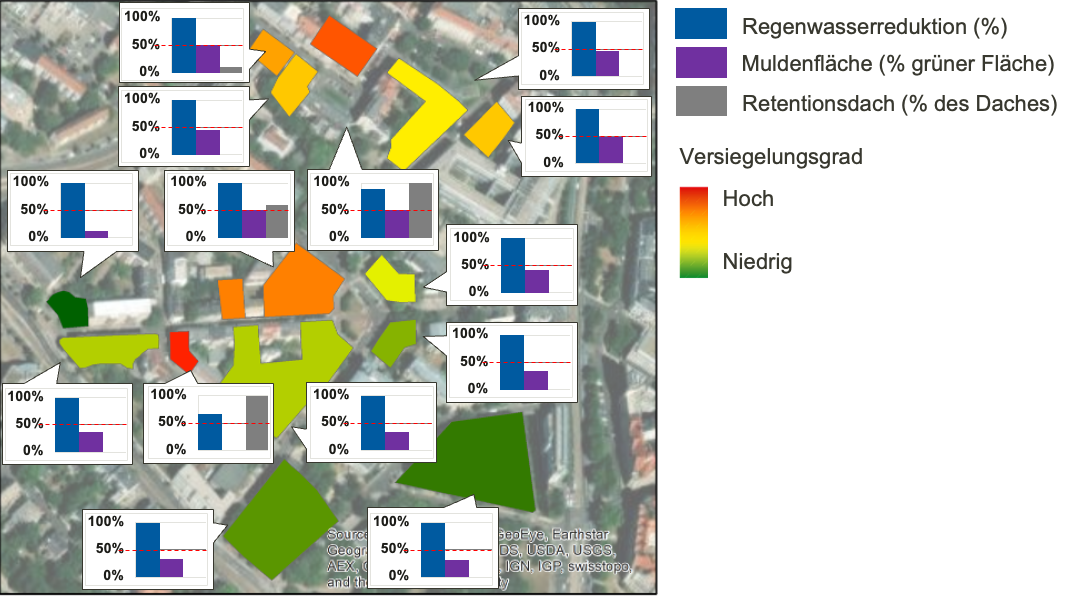 Preferred Solution for Rainwater Management.
Preferred Solution for Rainwater Management.
In addition, the irrigation demand and water availability for the neighborhood were calculated to demonstrate the potential for resource-efficient irrigation. The water availability and irrigation demand for construction phase 1 for the year 2018 were exemplified (Figure 5).
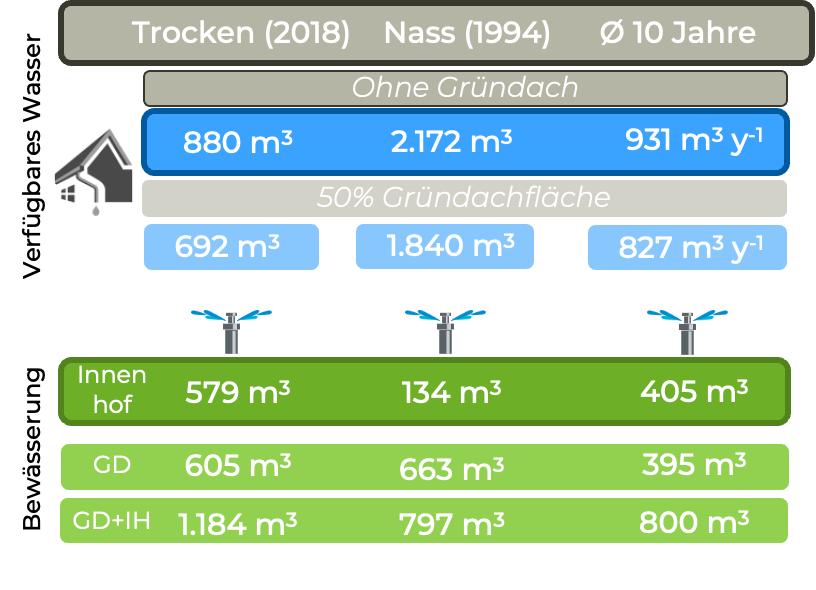 Water Availability and Irrigation Demand for Courtyard and Green Roof.
Water Availability and Irrigation Demand for Courtyard and Green Roof.
Product No. 3: Proposals for improving energy efficiency at the building level and derivation of standards for defined building types
This work package presented the current energy supply. Various alternatives for energy supply were also examined, such as the use of industrial waste heat, above-ground hydrothermal energy, geothermal energy, wastewater (ab) heat, underground hydrothermal energy, and exhaust (ab) heat. Additionally, various renovation scenarios were developed, and their heat requirements were calculated (Figure 6).
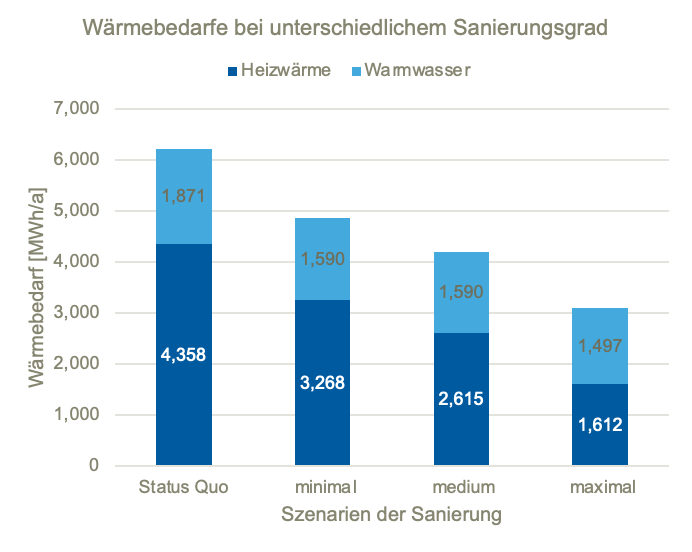 Renovation Scenarios and Their Heat Demand.
Renovation Scenarios and Their Heat Demand.
Product No. 4: Building type-specific toolbox for implementing blue-green infrastructure in existing structures
A concept study is prepared for the roof conversion to integrate green roofs and external drainage (Figure 7).
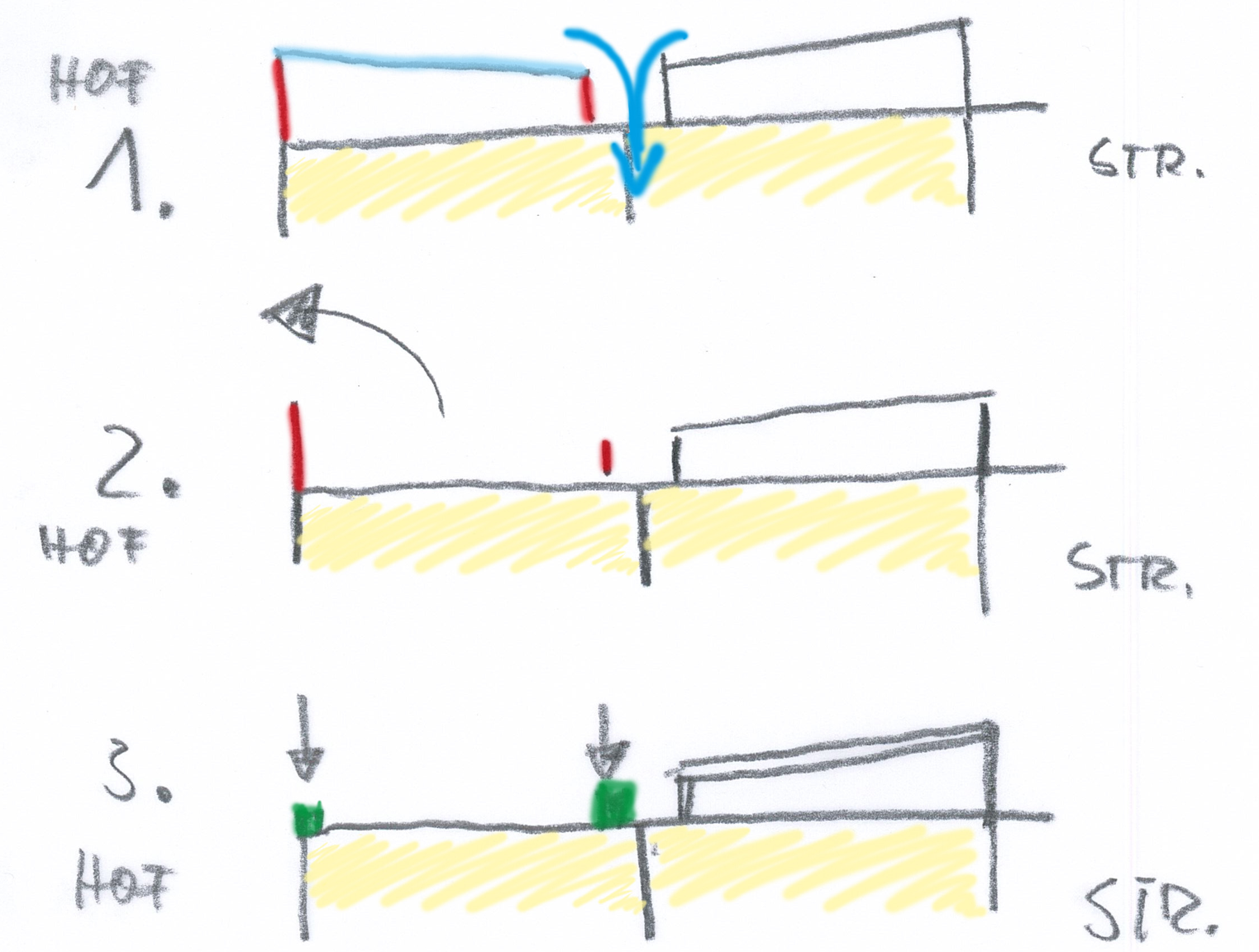
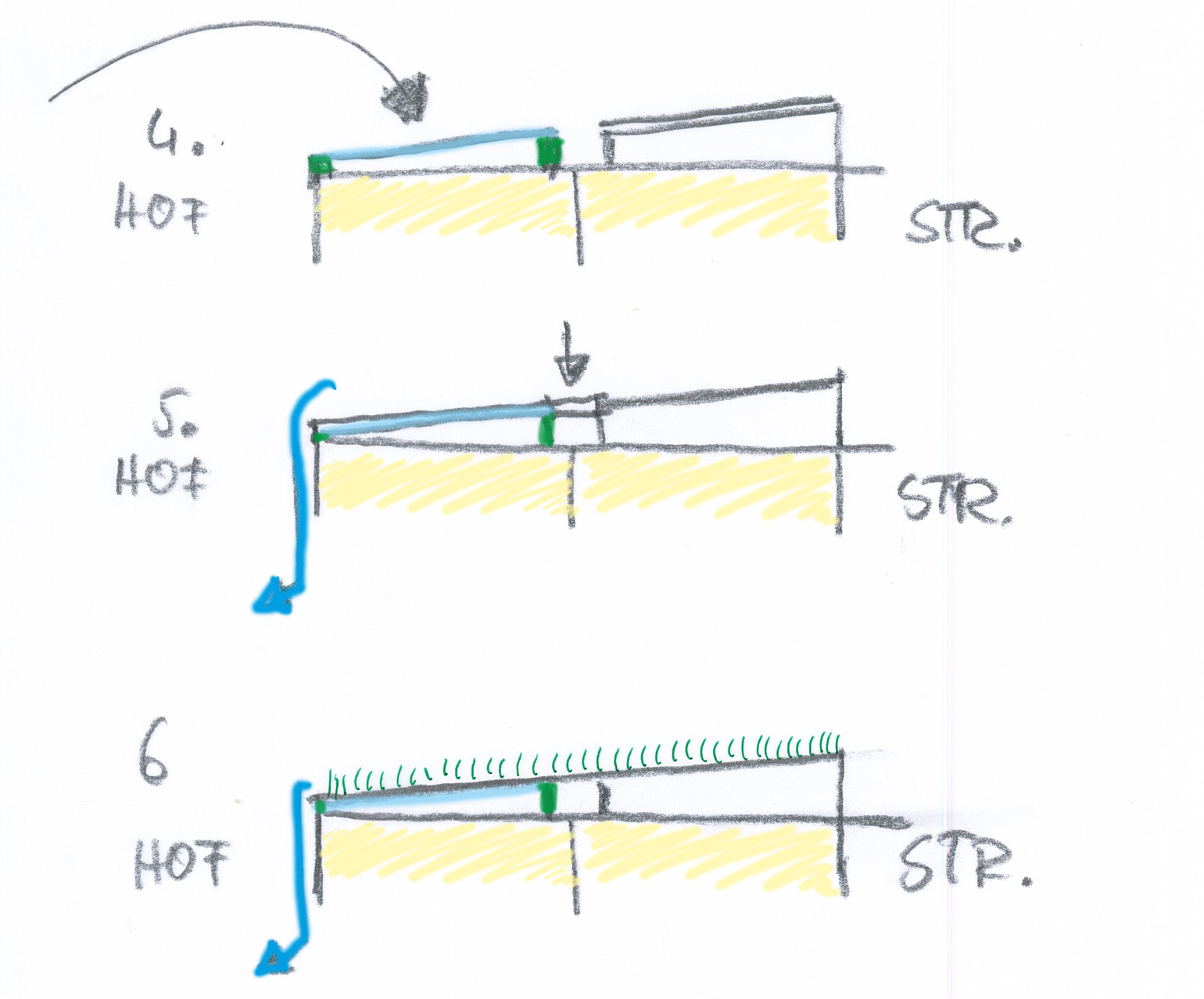
Concept of roof conversion for greening and drainage to the courtyard.
Contributors in the Work Package
- Bernd Plaul - Leipziger Wohnungs- und Baugesellschaft mbH (LWB)
- Marc Breulmann, Ganbaatar Khurelbataar, Jan Friesen – Helmholtz-Zentrum für Umweltforschung - UFZ
- Stefan Böttger, Martin Mehner, Michael Mirisch – Tilia GmbH
- Rüdiger Clausen, Jannis Clausen – gruen fuer stadt und leben (GFSL)
Purpose and questions of the work package
The fundamental question being addressed is: What contribution can blue-green infrastructures make to resource conservation and climate adaptation?
"Evaluated" examples are missing for the water-sensitive and energy-efficient renovation of existing buildings and neighborhoods that could serve as a reference for resource-efficient urban redevelopment. Using the example of building complexes (buildings, open spaces, courtyards), the technical implementation (retention, storage, infiltration, irrigation, energy) and the associated quantifiable performance/effects (relief of the sewer network, cooling, vitality of trees/vegetation, energy efficiency) are to be evaluated. This can serve as a blueprint for widespread implementation and, consequently, for sustainability, both in technological and planning terms.
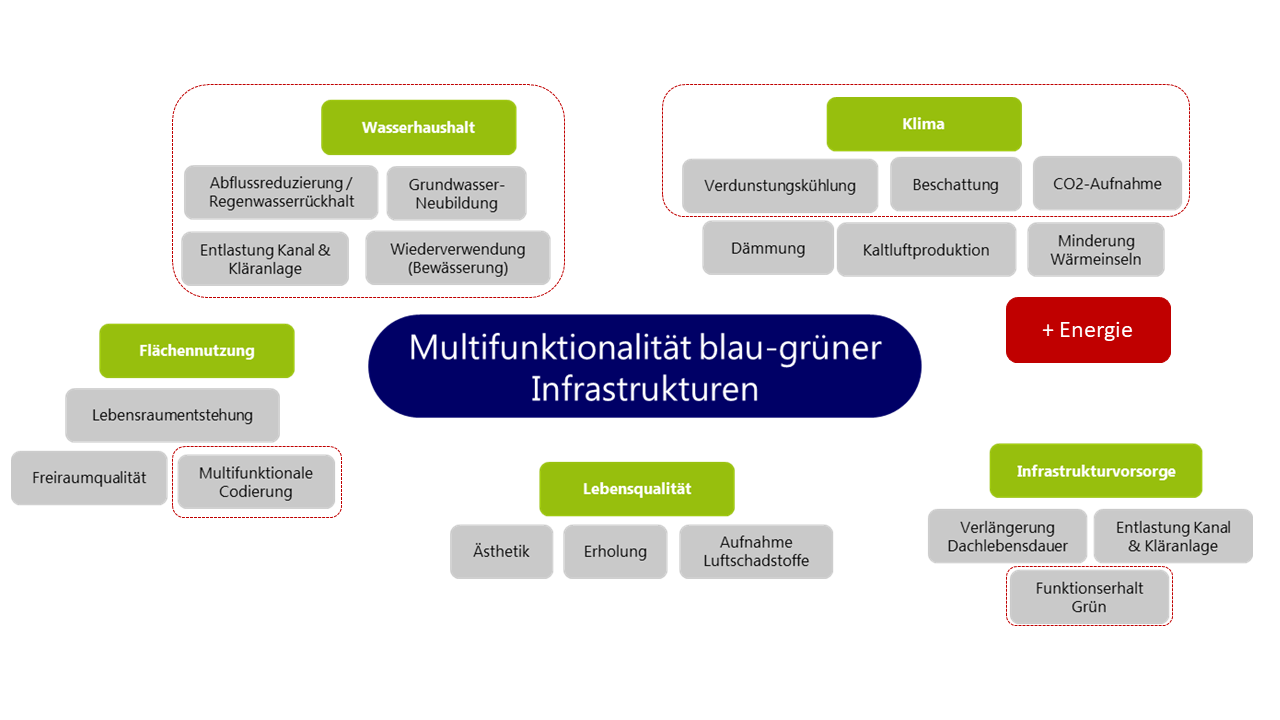 Stream Assessment Framework for Blue-Green Infrastructure (Source: Institut für Infrastruktur und Ressourcenmanagement, Universität Leipzig).
Stream Assessment Framework for Blue-Green Infrastructure (Source: Institut für Infrastruktur und Ressourcenmanagement, Universität Leipzig).
Planned products and results
A product of AP 3 is (building) profiles that describe and evaluate the effects of already implemented measures in the areas of 'BlueGreen' and 'Energy.' Furthermore, potential possibilities are to be highlighted. The goal of the profiles is to enable municipal decision-makers to make informed decisions for future renovation measures in the 'BlueGreen' and 'Energy' domains for municipal buildings in the city, using the profiles to implement the most effective measures.
While blue-green infrastructures are being constructed in many places, their impacts on microclimates are rarely examined. The objective is to conduct a microclimate simulation and calibrate it with empirical data. In addition to rooftop greening, special attention is given to the effects of blue-green infrastructures in courtyards and in the vicinity of various courtyards.
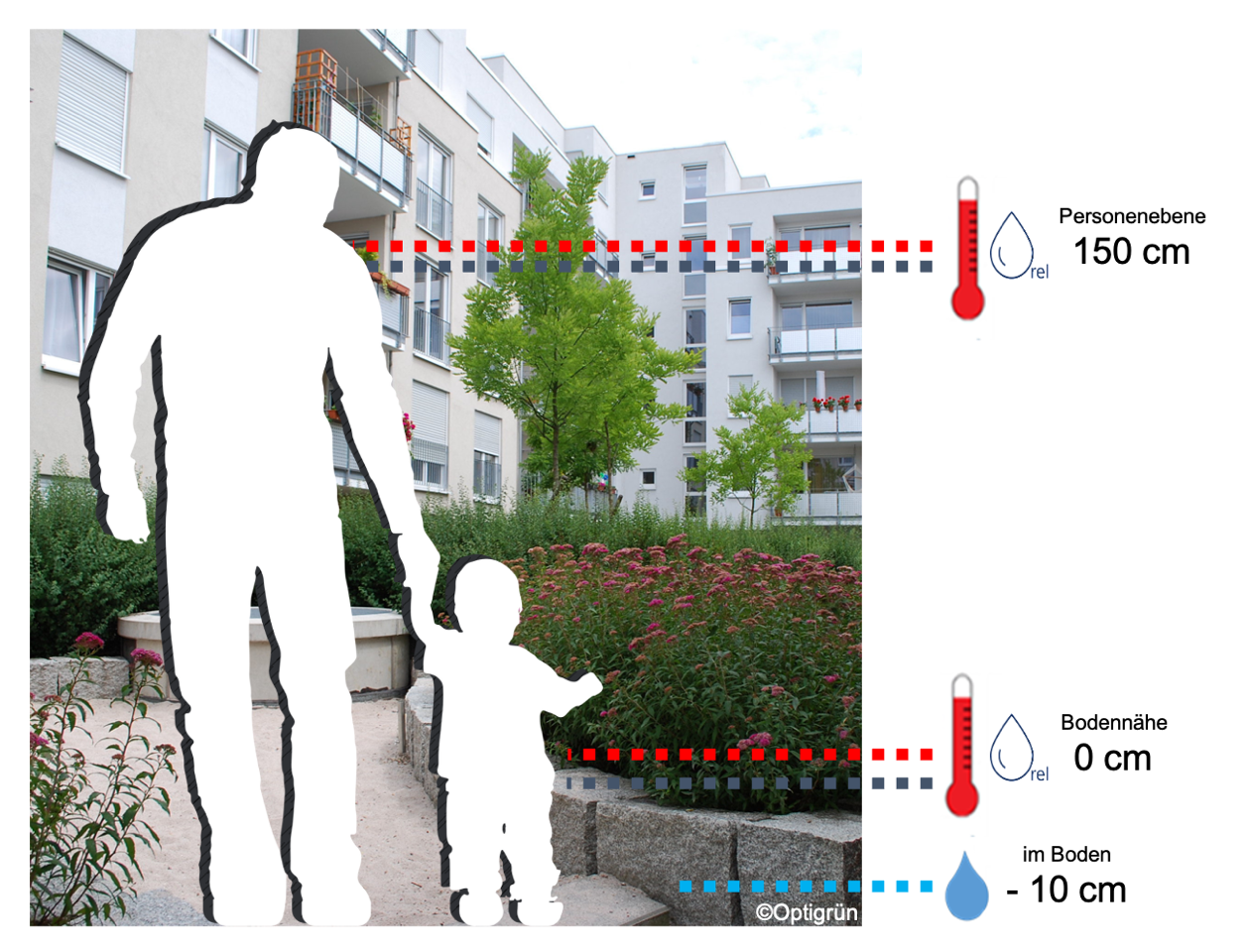 Temperature and humidity measurements at the personal level and near the surface, as well as soil moisture measurements (Source: Optigrün).
Temperature and humidity measurements at the personal level and near the surface, as well as soil moisture measurements (Source: Optigrün).
The practical implementation of integrated concepts for a 'water-sensitive urban district' requires not only the use of established individual technologies but also their multifunctional coupling. For this purpose, experimental data on water and climate balances at the block level are collected under local conditions and analyzed with regard to the natural water cycle. The results will be incorporated into ongoing planning and evaluation processes for blue-green infrastructures, as well as into a handbook for the design of coupled blue-green infrastructures for stormwater management and irrigation in water-sensitive urban areas. The handbook aims to define the requirements and procedures to be considered in the planning of coupled blue-green infrastructures for stormwater management and irrigation.
Information on the work package process
- For the profiles, renovation and conversion measures carried out primarily on municipal and public existing buildings in the Leipzig city area are evaluated.
- The structure and content of the profiles are discussed and coordinated with future users at the city level to create an applicable product.
- Selection of suitable objects (sealed, green, blue-green) from an existing list of objects.
- Equipping the objects with measurement technology.
- Analysis of the measurements and input of the data into the climate simulation.
Contributors to the work package
- Stefan Böttger – Tilia GmbH
- Sabine Lautenschläger – Universität Leipzig
- Ämter der Stadt Leipzig
- Dr. Lucie Moeller – Helmholtz-Zentrum für Umweltforschung – UFZ
- Dr. Marc Breulmann – Helmholtz-Zentrum für Umweltforschung – UFZ
- Katy Bernhard – Helmholtz-Zentrum für Umweltforschung – UFZ
- Milena Mohri – Optigrün international AG
- Dominik Gößner – Optigrün international AG
Purpose and questions of the work package
In the context of the BMBF project Leipzig BlueGreen, Project Phase II, we are investigating the contributions that blue-green infrastructures can make to resource conservation and climate adaptation, especially in urban risk zones (focus areas). Against the backdrop of the multifunctionality of blue-green infrastructures, the assessment initially focuses on water-related aspects (including water balance, water protection, sewer network relief) and the irrigation water requirements of blue-green infrastructures, contributions to mitigating heat islands, climate protection, and land-use conflicts. Detailed hydraulic calculations are conducted as scenarios to support this evaluation.
Planned products and results
Taking into account essential influencing factors on the feasibility of potential measures in the city-wide context, information foundations are developed for deriving BlueGreen investment potential maps and integrated into the Geodata portal of the city of Leipzig. Based on this, recommendations for future investment projects in public properties (City of Leipzig, Leipzig Housing Company (LWB), Leipzig Water (L-Wasser), or public investments in the L-416 district) are derived to mitigate prioritized climate-related risks through blue-green measures.
To illustrate these recommendations, on the one hand, the evaluation profiles developed in AP 3.1 for selected building complexes are used. On the other hand, the derivation of (target) indicators for water-sensitive urban development is supported, and recommendations for prioritized implementation measures are derived. Both property-related measures and street spaces are examined, with a focus on Category I streets according to DWA A 102.
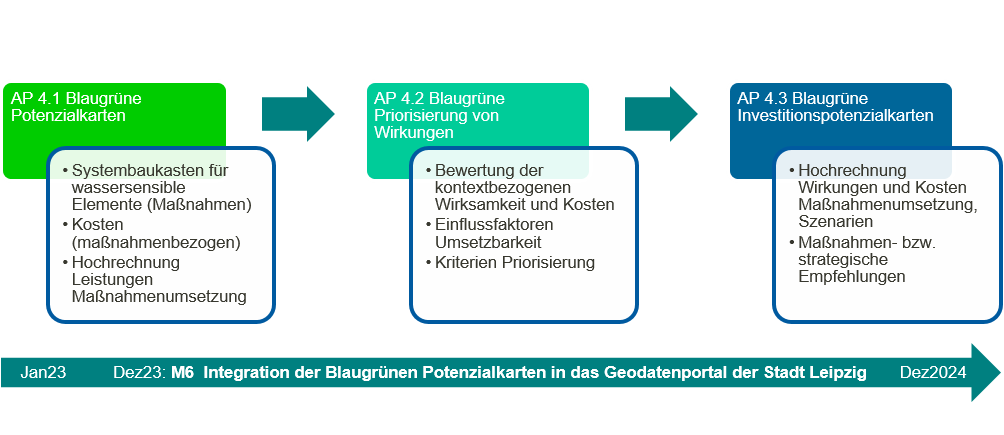 Procedure for work package 4 (in german).
Procedure for work package 4 (in german).
Contributors to the work package
- Tilo Sahlbach – Institut für Wasserbau und Siedlungswasserwirtschaft (IWS) an der HTWK Leipzig
- Dr. Sabine Lautenschläger, Erik Hofmann – Lydie Laforet, Dr. Stefan Geyler, Institut für Infrastruktur und Ressourcenmanagement (IIRM) an der Universität Leipzig
- Dr. Uwe Winkler – Kommunale Wasserwerke Leipzig GmbH (L-Wasser)
Purpose and questions of the work package
How can the implementation of blue-green infrastructures be integrated into existing planning processes in Leipzig, transferred to other municipalities and how should the political and legal framework be adapted?
The nationwide implementation of blue-green infrastructures encounters obstacles in administrative processes, financing instruments and legal requirements. These framework conditions need to be adapted in order to enable and ensure the implementation of blue-green measures for a large number of projects, so that the consideration of blue-green issues is not limited to model projects.
Planned products and results
Compiling Leipzig's approaches to planning, coordinating and financing blue-green urban development and identifying perspectives
The project partner, the City of Leipzig, is examining the existing planning processes, particularly in the city planning department, and checking where the interests of water-sensitive urban development can best be incorporated. The aim is to incorporate sustainable water management into internal administrative planning processes from the outset.
In addition, incentive systems are to be identified to encourage owners to get involved on private land, as there is great potential for decentralized rainwater management on their land.
Furthermore, existing sectoral plans and basic data collection for the city of Leipzig are to be compiled. The consolidation will serve as a basis for the further development of the municipal framework in relation to blue-green infrastructures.
WP 5.2 "BlueGreen Governance" conference in Leipzig in the 2nd quarter of 2024
As a project partner, the Federal Environment Agency will promote nationwide and EU-wide exchange on organizational, legal and financial issues relating to BlueGreen urban development. A detailed analysis of the stakeholder landscape of water-conscious urban development will be carried out first. Relevant stakeholders from city administrations, professional associations and scientific institutions will then meet at a specialist conference to discuss the above-mentioned issues.
Expert workshops will be held to discuss important aspects (administrative structures, funding/financing, planning) in more detail.
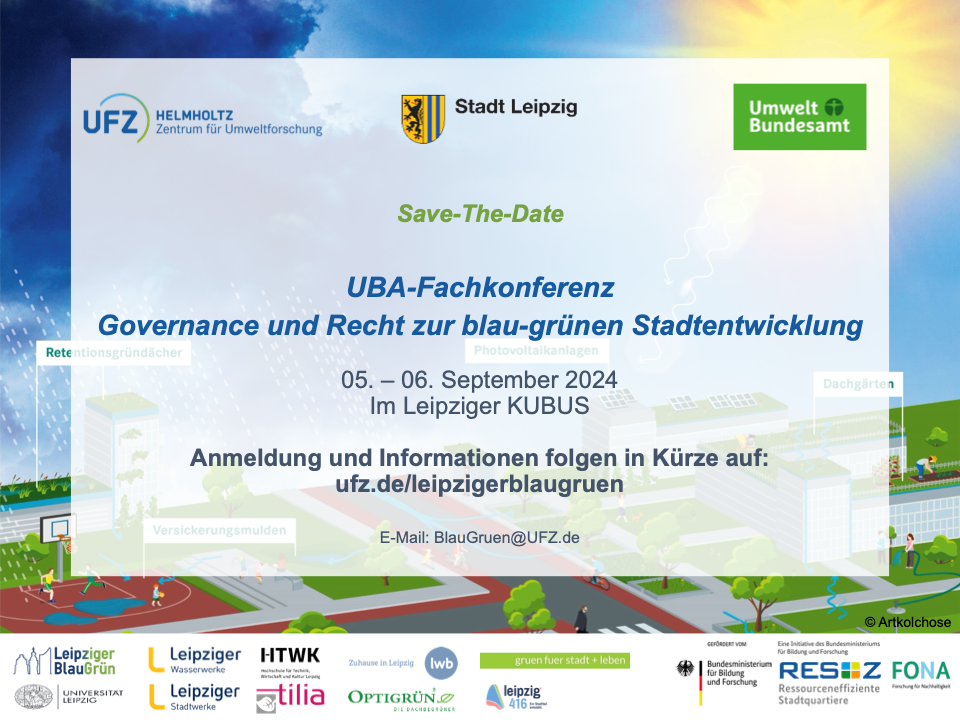
WP 5.3 Best practices and better framework conditions
In cooperation with the German Association of Cities, experts from 100 cities were surveyed on the political and legal framework conditions for blue-green urban development. The results were presented at the German Association of Cities on 19.09.2023 in Leipzig. As many as 20% of cities give high priority to urban climate adaptation through blue-green infrastructures. In many of the cities surveyed, wastewater disposal concepts, for example, are supplemented with aspects of blue-green development, while binding city-wide plans are still rare. The presentation "Political and legal framework conditions for blue-green infrastructures in German cities" can be found here.
In addition, as part of work package 5.3, a workshop on the topic of law in water-sensitive urban development was held on the premises of the New Town Hall in November 2023 in collaboration with the steering network for water-sensitive urban development. After consulting with colleagues from the urban planning office, Dr. Reese prepared informative content for colleagues from the city administration. The workshop provided a helpful platform to identify legal hurdles in water-sensitive urban development across all departments and to take a further step towards making Leipzig a sponge city.
The members of the work package are regularly invited to consultations by political parties, ministries, members of parliament and associations and asked for proposals for amended political and legal framework conditions (for example, most recently in the context of the amendment to the Building Act in the Ministry of Urban Development). We have summarized these recommendations for action to federal policymakers in the policy paper "Urbane Wasserwende" (download here). A further policy paper will then address municipal decision-makers: "Administrative, financial and legal challenges and best practices of climate-proof, blue-green urban development".
Time Table
 Abbildung 1: Zeitlicher Ablauf des Arbeitspakets 5.
Abbildung 1: Zeitlicher Ablauf des Arbeitspakets 5.
Contributors to the work package
- Dr. Moritz Reese - Helmholtz-Zentrum für Umweltforschung – UFZ
- Dr. Frank Hüesker - Helmholtz-Zentrum für Umweltforschung – UFZ
- Sophie Wehmeier - Stadtplanungsamt Stadt Leipzig
- Dr.-Ing. Nathan Obermaier – Umweltbundesamt – UBA
- Richard.Olariu – Umweltbundesamt – UBA

